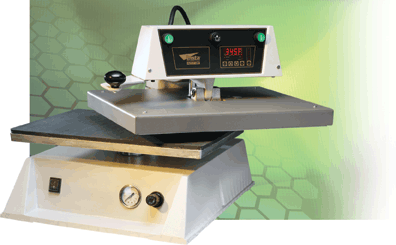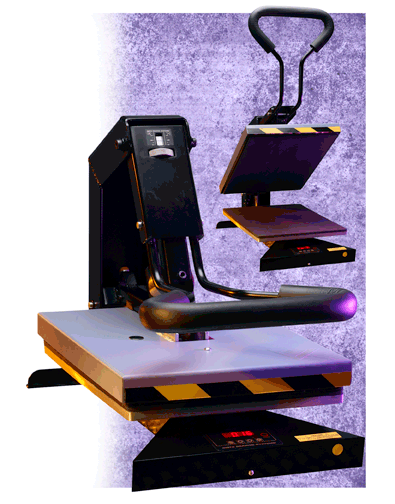What To Look For In A Heat Press
April 21, 2010

Today’s heat applied graphics market is flooded with different types of heat presses – all making promises about quality and performance that not all of them can keep. With all of the choices out there, how do you make an unbiased, educated decision on what you truly need out of a heat press? Many of the "How-To" print techniques International Coatings features incorporate the use of a heat transfer machine, including simple techniques such as applying foil to a design.
We have asked Sara Kahane, Sales and Marketing Executive of Insta Graphic Systemsto give us the 411 regarding heat presses. Insta has been a worldwide leader in heat press transfer technology and manufacturing for over 50 years! So here is Sara with more details on what to look for:
“I have weeded out the fluff, and have put together a list of the key elements to look for in a heat press:
- Even Temperature – Even temperature is probably the most important feature in a heat press. The best way to ensure even heating is to find a heat press that has a cast-in tubular heating element that runs from edge to edge and is evenly spaced throughout the entire platen to insure even heat distribution – this means that the coiled heating element is actually cast into the upper platen, instead of sitting on top, so it heats the metal from within.
![Instagraph_228_03[1] Insta 228 Manual](https://www.iccink.com/assets/uploads/instagraph_228_031.gif?w=150) Insta 228 Manual
Insta 228 Manual- Even Pressure – Even pressure is another key element in a good press. You want to find a heat press that has the source of pressure coming down from the center of the platen instead of from the back. When pressure comes from the back, you’ll get higher pressure towards the rear of the platen and less in the front, and as a result you will get an uneven application. When the pressure source (the piston or cam depending on what type of machine you’re using) comes down from the center of the platen, pressure is dispersed evenly out from the center towards all four corners giving you an even application.
- Materials - If you’re going to be using your heat press consistently, you want to make sure that the materials used to make the heat press are strong enough to withstand constant use without warping or bending. We have found cast aluminum to be the strongest and most durable.
- Design – When looking for a heat press, you should find a heat press that is ergonomically designed for ease-of-use and low maintenance. Not only will these features make the operator’s life easier, but they will help you get the most out of your machine and help extend its useful life.
 Insta 728 Automatic, Swing-Away
Insta 728 Automatic, Swing-Away- Models – It’s important to choose a heat press model that is going to suit your particular needs. Swing-away models (see image of Insta 728 Automatic heat press for an example of a swing-away design) are great because they give you unobstructed access to the entire platen without having to worry about burning your knuckles on the upper heating element. Also, with a swing-away, the heat is kept away from your face which helps keep the operator from getting too hot. Since the upper platen swings to the side, instead of up and down, they tend to be easier for us short people to use! But if you’re tight on space, I recommend going for a clam shell (see image of Insta 158 Manual heat press for an example of a clam shell design) – since the movement is up and down, it doesn’t require a lot of space to operate. They are great for small shops and home use.
 Insta 158 Manual Heat Press
Insta 158 Manual Heat Press- Manual vs. Automatic - If you’re doing high volume production, anything more than 500 pcs per day, I strongly recommend going automatic. Because automatics are much easier for the operator to use, your output won’t drop over the course of the work day – production speed should stay consistent. The operator won’t get tired and start to slow down. Automatics are also built for the long-haul – they are made to go the distance. If you are printing thousands of garments per day, I would recommend going into 220/240 volt – the higher wattage helps recover the heat on the upper platen quicker, which prevents too much temperature variance between applications.
So before you go out and buy your heat press, make sure you do your homework. Find a heat press that has the key elements for quality and reliability and make sure you’re clear on what you’re using it for so you get a model that suits your needs.”
About Insta Graphic Systems:
Insta Graphic Systems uses only top grade materials and manufacture all of their heat press machinery here in the U.S.A. Since 1959, Insta Graphic Systems has been the world’s leader in heat transfer technology. Insta prides itself in setting the standard for quality heat transfer machines, custom heat transfers and the interaction between these two products – the application process. Insta provides its products and services to the athletic, entertainment, fashion, sports, medicine, promotional, color copy and premium markets. Our customers include major apparel manufacturers and their contractors worldwide. For more information on Insta and its products, please visit www.instagraph.com. For more on International Coatings and our textile screen print ink products, go to www.iccink.com.


